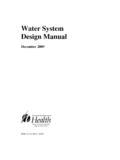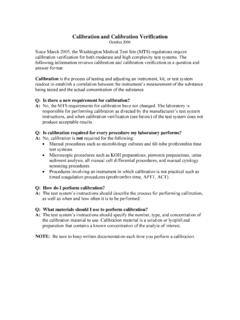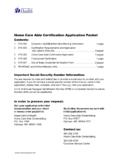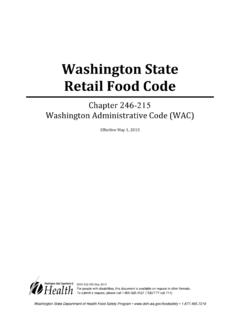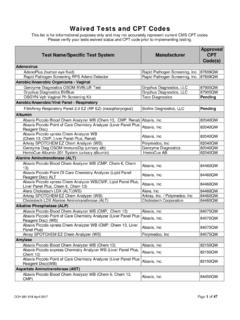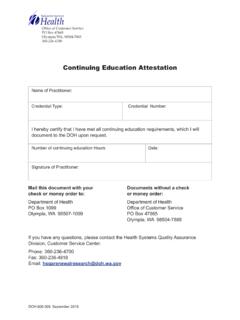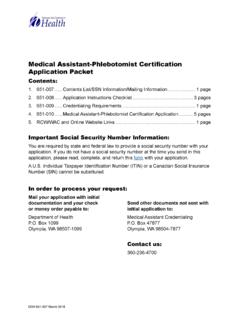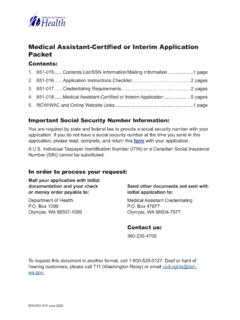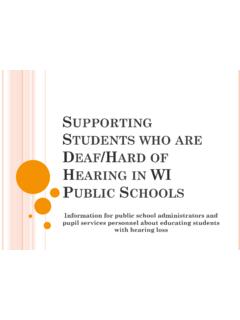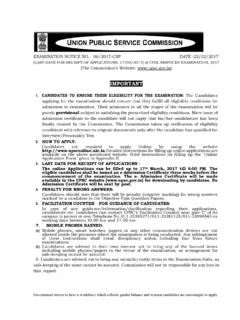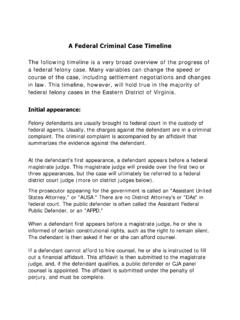Transcription of Cloth Face Coverings Guidance During COVID-19
1 Updated September 3, 2021. DOH 820-131. Cloth Face Coverings Guidance During COVID-19 . Summary of September 3, 2021 Changes Updated information to align with and link to current orders. Introduction Face Coverings or masks, along with getting vaccinated, staying six feet of physical distancing from others outside your home, avoiding crowds and poorly ventilated spaces, covering your coughs and sneezes, and washing your hands often, can significantly slow or stop the spread of COVID-19 . Even if you are fully vaccinated, at this time it is required to wear face Coverings in certain public settings. When you wear a face covering , you help protect others around you as well as yourself. In responding to this pandemic, we have learned that there are times and places where wearing a face covering can greatly reduce transmission of COVID-19 from person-to-person, saving lives and helping to keep the economy open safely and wisely. A Cloth face covering is anything the completely covers your mouth and nose, and fits securely on the sides of your face and under your chin.
2 It should be made of two or more layers of tightly woven fabric with ties or straps that go around your head or behind your ears. A face shield with a drape can be used by people with developmental, behavioral, or medical conditions that prevent them from wearing a Cloth face covering . Face shields with a Cloth drape may also be used; including by children in child care, day camp, and K-12 settings if a Cloth face covering is not tolerated. In the workplace, masks or respirators may be required as they are more protective than Cloth face Coverings . Guidance from the Centers for Disease Control and Prevention (CDC) recommends strategies to improve mask fitting to more effectively slow the spread of COVID-19 . These strategies include wearing a Cloth mask over a medical procedure mask, knotting the ear loops of a medical procedure mask, using a mask fitter, or using a nylon covering over a mask. In addition, DOH. does not recommend the use of masks with exhalation valves or vents, or single layer bandanas and gaiters.
3 Respirators with exhalation valves may be used used in accordance with Guidance published by the Washington State Department of Health (DOH) and Washington State Department of Labor & Industries (L&I). Please visit DOH's webpage on face Coverings for a complete list of frequently asked questions. Additional information can be found on the CDC's webpage for face masks. Current Mandates and Health Orders The current public orders that require people to wear face Coverings or masks in certain settings include: The general public order: This order from the Secretary of Health requires Washingtonians to wear face Coverings in public indoor spaces, regardless of vaccination status with limited exceptions and exemptions. People are individually responsible to comply with this order, however businesses also have responsibilities to enforce this with their employees and customers. Please see the orders below and the Secretary of Health's Mask Order FAQ for additional information.
4 The Centers for Disease Control and Prevention order: This order from the CDC requires the wearing of face Coverings by travelers to prevent spread of the virus that causes COVID-19 . This order must be followed by passengers on all public transportation and in transportation hubs including but not limited to airplanes, ships, ferries, trains, subways, buses, taxis, and ride- shares. Operators of public transportation must require all passengers to wear face Coverings when boarding, disembarking, and for the duration of travel. More information can be found on the CDC's webpage for Legal Authorities. The workplace order: Requiring face Coverings or masks for employees, in all industries, regardless of vaccination status, in indoor spaces accessible to the public . Employers may also choose to require face Coverings even if the space is not accessible to the public and employees are fully vaccinated. Employers must provide face Coverings if workers do not have them; and employers must allow employees to wear a mask or other protective equipment if they choose to.
5 Employers are responsible to comply with this order and the Department of Labor &. Industries enforces it. Governor's proclamation: Information on the responsibilities and expectations for businesses involving customers and employees is listed in the governor's COVID-19 Facial covering Guidance for Employers and Businesses and in Proclamation Washington Ready and Proclamation 21-08 Safe Workers. Local orders: Local health officials have the authority to put health orders in place to control and prevent the spread of disease within their jurisdiction. These orders may be more strict than statewide orders, but may not be less strict. Check with the local health jurisdiction and follow all health orders in place for that area. When You've Been Fully Vaccinated People are considered fully vaccinated: 2 weeks after their second dose in a 2-dose series, like the Pfizer or Moderna vaccines, or 2 weeks after a single-dose vaccine, like Johnson & Johnson's Janssen vaccine. If it has been less than 2 weeks since your final dose, or if you still need to get your second dose, you are NOT fully protected.
6 Keep taking all prevention measures until you are fully vaccinated. Fully vaccinated individuals do not need to quarantine unless symptomatic but they should get tested 3-5 days after exposure if identified as a close contact of someone who has COVID-19 . If 2. symptoms develop, follow isolation recommendations and get tested. Residents or employees of group settings, like a correctional or detention facility or group home, should quarantine and get tested if identified as a close contact regardless of vaccination status. Currently, due to high COVID-19 disease activity in Washington state and across the nation, face covering or masks are required in public indoor settings regardless of vaccination status. There are limited exceptions to wearing face Coverings or masks, and these are outlined in the Secretary's Face covering Order and FAQ. In areas that are not accessible to the public , employers may allow fully vaccinated employees, whose status has been verified by the employer, to remove their face covering or mask while indoors.
7 Businesses retain the right to require masks in their establishments for staff and/or customers, and to ask for proof of vaccination. Refer to L&I for current information on face covering requirements in the workplace. More COVID-19 Information and Resources Stay up-to-date on the current COVID-19 situation in Washington, Governor Inslee's proclamations, symptoms, how it spreads, and how and when people should get tested. See our Frequently Asked Questions for more information. A person's race/ethnicity or nationality does not, itself, put them at greater risk of COVID-19 . However, data are revealing that communities of color are being disproportionately impacted by COVID-19 - this is due to the effects of racism, and in particular, structural racism, that leaves some groups with fewer opportunities to protect themselves and their communities. Stigma will not help to fight the illness. Share accurate information with others to keep rumors and misinformation from spreading.
8 WA State Department of Health 2019 Novel Coronavirus Outbreak ( COVID-19 ). WA State Coronavirus Response ( COVID-19 ). American Academy of Pediatrics Cloth Face Coverings for Children During COVID-19 . Find Your Local Health Department or District CDC Coronavirus ( COVID-19 ). Stigma Reduction Resources Use of Cloth Face Coverings to Help Slow the Spread of COVID-19 (CDC). How to Make An Accessible, Deaf-Friendly Face Mask (HSDC). Have more questions? Call our COVID-19 Information hotline: 1-800-525-0127. Monday 6 to 10 , Tuesday Sunday and observed state holidays, 6 to 6 For interpretative services, press # when they answer and say your language. For questions about your own health, COVID-19 testing, or testing results, please contact a health care provider. To request this document in another format, call 1-800-525-0127. Deaf or hard of hearing customers, please call 711 (Washington Relay) or email 3.
